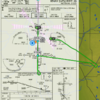WannFly
Final Approach
probably a question for my CFII, but just did a test flight and got a little surprised by what GTN had me do.
disclaimer : all under VFR, with permission from KFAR Approach and they knew what i was doing and i was cleared (i am pretty sure the controllers expect me to do dumb stuff anyway). I am not rated.
I was in the SE of KFAR and went to KOBME (IAF) to RNAV 36 to test out how the plane will fly, coupled approach. i was expecting after reaching KOBME it will do one turn in hold and then fly the rest of the approach. instead, when i punched in direct KOBME, it asked if i would like to fly the course reversal, to which i said yes and instead of doing the actual hold, it took me further south and made a teardrop entry to the approach course, i was outside of the hold area from what i can tell, wondering if there is a way to overlay my track on top of a approach chart to confirm.

Flight aware shows the track i flew, well i didnt, the AP did:

So what did i do wrong and why my expectation to do a turn in the hold turned down by GTN?
disclaimer : all under VFR, with permission from KFAR Approach and they knew what i was doing and i was cleared (i am pretty sure the controllers expect me to do dumb stuff anyway). I am not rated.
I was in the SE of KFAR and went to KOBME (IAF) to RNAV 36 to test out how the plane will fly, coupled approach. i was expecting after reaching KOBME it will do one turn in hold and then fly the rest of the approach. instead, when i punched in direct KOBME, it asked if i would like to fly the course reversal, to which i said yes and instead of doing the actual hold, it took me further south and made a teardrop entry to the approach course, i was outside of the hold area from what i can tell, wondering if there is a way to overlay my track on top of a approach chart to confirm.

Flight aware shows the track i flew, well i didnt, the AP did:

So what did i do wrong and why my expectation to do a turn in the hold turned down by GTN?
Last edited:


